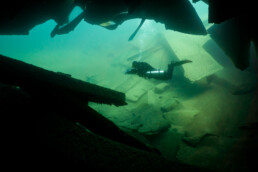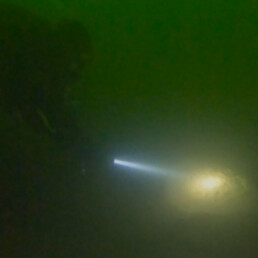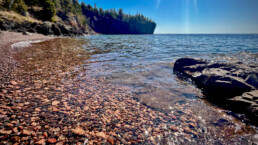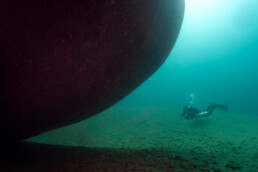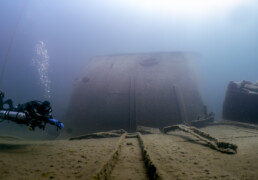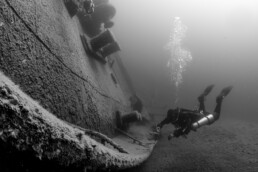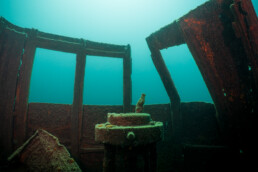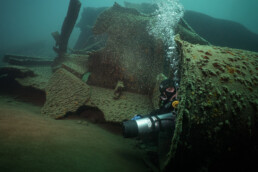Diving the Madeira (Eventually): A Slow Descent into Competence
There are few things that feel more “Lake Superior” than standing at the edge of a forest, fumbling with scuba gear while swatting at mosquitoes the size of corporate drones, mentally preparing to plunge into 36-degree water to visit a ship that’s been rusting politely on the bottom for 120 years.
The Madeira. For local divers, it’s the wreck. The big one. A proper bucket-lister. Accessible from shore, just under the recreational depth limit at 130 feet, and absurdly long—436 feet, with a beam of 50. You could land a small plane on it, if it weren’t, you know, underwater. And a shipwreck. And a protected historical site. But still.
I’d attempted this dive twice before. The first time was sometime in the last century, with a college buddy who was brilliant in the way that Einstein was brilliant, if Einstein had also been criminally negligent as a dive buddy. We dove it at night, despite neither of us having ever seen it before, and despite the small but crucial detail that the iron ore it once carried makes compasses behave like a pigeon in a tornado. My memories of the actual wreck are almost entirely replaced by a riveting mental slideshow of me surfacing alone, in the dark, waiting out a safety stop at 15 feet while imagining I was about to be eaten by a freshwater kraken.
The second attempt came just last year, with Heather—a vastly more competent dive buddy whose credentials make James Bond look under-qualified. Dive master. Trimix certified. Cave trained. A couple thousand dives under her belt, although she’s stopped counting, because after a certain point, what’s the difference between 1,800 and 2,000? You’re either Poseidon or you’re not.
At the time, I barely knew her. Which is probably why I tried very hard to appear not like someone teetering on the edge of an anxiety spiral at the idea of descending past 90 feet on a rebreather I’d had for less than a year. A rebreather, I might add, that I was still getting used to—a complicated little contraption that requires you to be part diver, part pilot, and part Zen monk to operate calmly. In exchange, it offers longer dive times, little noise, and the persistent sense that your life depends on remembering which button not to press – to put it dramatically 😉
Conditions that day were deceptively perfect: bluebird skies, dead calm water, and balmy—for northern Minnesota—temperatures hovering around 70°F. It all lulled me into a false sense of security until I found myself descending through 50 feet of soupy darkness with a leaky mask and all the emotional stability of a raccoon in a thunderstorm.
The visibility was ten feet at best and got worse as we descended. Heather, familiar with every rivet on the wreck, floated ahead like a mermaid with a map, while I followed like a haunted Roomba—anxious, disoriented, and trying to pretend I wasn’t. We went deep. Probably deeper than I had any business going at the time. I didn’t say anything. I didn’t want to look like a beginner, which, of course, I absolutely was.
We surfaced safely. I looked fine. From the outside, I was probably the picture of cool composure. Inside, it was a screaming goat rodeo.
Over the winter, Heather and I kept diving. A lot. In the big lake. In January. Because once you get used to slithering into a drysuit in sub-zero winds while trying to keep your fingers from going numb before you can close your zipper, nothing seems particularly difficult afterward.
At some point I admitted my struggle that day on the Madeira, my general unease with anything deeper than 50 feet, and my Olympic-level ability to catastrophize while underwater. She was gracious, as Heather always is, and asked if I wanted to work on it.
I did.
So, a few days ago, we went back. Same wreck. Same gear. Same diver (me), but with a little more experience and a lot more humility. And this time, it all came together.
The lake, as if to apologize for its previous behavior, gave us flat seas and crystal visibility. The air was warm, the sunlight sparkled on the surface, and the water—while still barely above freezing—was welcoming in its own frosty, indifferent way. We descended slowly, communicating with hand signals like two polite mimes in a glass elevator. At 90 feet, we reached the smokestack—an enormous metal cylinder that Heather, clearly born without the fear gene, immediately swam through like it was a lazy river ride. I opted instead to observe, snap a couple photos, and contemplate whether a 4-foot-wide steel tube in a sunken freighter was really the best place to discover a latent case of claustrophobia.
The rest of the dive was, dare I say, enjoyable. I took photos. Good ones. I was present, more curious than anxious. At one point, Heather floated in perfect trim beneath a canopy of mangled steel and sunlight, and I snapped what might be my favorite photo of the year. She looked like an astronaut. I looked like a guy who finally got to see the wreck he’d been chasing for decades.
We surfaced happy. Genuinely happy. Not just “we’re alive” happy, but “that was actually lovely” happy. The dive was calm, beautiful, and redemptive. I’d finally seen the Madeira—not just survived it.
And it’s only mid-May. There’s a whole season of diving ahead. I may still get nervous before going deep, but I’m starting to trust that if I keep breathing, keep learning, and keep working on skills, I might just turn into the diver I’ve always wanted to be.
Well, that or freeze to death trying. But either way, it’ll make a good story.

